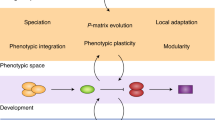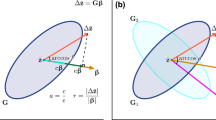Abstract
The degree of integration of multidimensional phenotypes has an important place in evolutionary biology, pertaining to the structure of variation that is available for natural selection to work on and therefore to the evolutionary potential of the phenotype. Various indices have been suggested in the literature for measuring integration level, yet their statistical properties have remained mostly unstudied to date. In this study, I used simulations and resampling procedures in order to compare the distributions and sampling properties of different indices. I simulated heterogeneous correlation matrices that ranged widely in their integration level. I applied non-parametric bootstrapping to explore the effect of sampling on recovering the true integration value of these matrices. In addition, I generated the statistical power space for one of the integration indices—the relative standard deviation of the eigenvalues. The results show that the relative variance of eigenvalues maps exactly onto the mean coefficient of determination, and that the index suggested by Hansen and Houle (J Evol Biol 21:1201–1219, 2008) is the same as Van Valen’s (J Theor Biol 45:235–247, 1974) redundancy index, both of which have some undesirable sampling properties that render them less useful in most practical situations. Based on the power analysis, a sample of 30–40 specimens can be considered a sufficient minimum for most studies. The R codes provided here can be utilized by other researchers to yield case-specific insights.









Similar content being viewed by others
References
Ackermann, R. R. (2005). Ontogenetic integration of the hominoid face. Journal of Human Evolution, 48, 175–197.
Agrawal, A. F., & Stinchcombe, J. R. (2009). How much do genetic covariances alter the rate of adaptation? Proceedings of the Royal Society B: Biological Sciences, 276, 1183–1191.
Armbruster, W. S., Hansen, T. F., Pelabon, C., Perez-Barrales, R., & Maad, J. (2009). The adaptive accuracy of flowers: Measurement and microevolutionary patterns. Annals of Botany, 103, 1529–1545.
Cane, W. P. (1993). The ontogeny of postcranial integration in the common tern, sterna hirundo. Evolution, 47, 1138–1151.
Cheverud, J. M. (1982). Phenotypic, genetic, and environmental morphological integration in the cranium. Evolution, 36, 499–516.
Cheverud, J. M. (1984). Quantitative genetics and developmental constraints on evolution by selection. Journal of Theoretical Biology, 110, 155–171.
Cheverud, J. M. (1988). A comparison of genetic and phenotypic correlations. Evolution, 42, 958–968.
Cheverud, J. M. (1996). Quantitative genetic analysis of cranial morphology in the cotton-top (Saguinus oedipus) and saddle-back (S. fuscicollis) tamarins. Journal of Evolutionary Biology, 9, 5–42.
Cheverud, J. M., Rutledge, J. J., & Atchley, W. R. (1983). Quantitative genetics of development: Genetic correlations among age-specific trait values and the evolution of ontogeny. Evolution, 37, 895–905.
Cheverud, J. M., Wagner, G. P., & Dow, M. M. (1989). Methods for the comparative analysis of variation patterns. Systematic Zoology, 38, 201–213.
Cohen, J. (1988). Statistical power analysis for the behavioral sciences (p. 567). London: Routledge.
Cohen, J. (1990). Things I have learned (so far). American Psychologist, 45, 1304–1312.
Draghi, J., & Wagner, G. P. (2008). Evolution of evolvability in a developmental model. Evolution, 62, 301–315.
Drake, A. G., & Klingenberg, C. P. (2010). Large-scale diversification of skull shape in domestic dogs: Disparity and modularity. The American Naturalist, 175, 289–301.
Emerson, S. B., & Hastings, P. A. (1998). Morphological correlations in evolution: Consequences for phylogenetic analysis. Quarterly Review of Biology, 73, 141–162.
Fisher, R. A. (1928). The general sampling distribution of the multiple correlation coefficient. Proceedings of the Royal Society of London Series A, 121, 654–673.
Fu, J., & Murphy, R. W. (1999). Discriminating and locating character covariance: An application of permutation tail probability (ptp) analyses. Systematic Zoology, 48, 380–395.
Genz, A., & Bretz, F. (2009). Computation of multivariate normal and T probabilities. Heidelberg: Springer.
Genz, A., Bretz, F., Miwa, T., Mi, X., Leisch, F., Scheipl, F., et al. (2011). mvtnorm: Multivariate normal and t distributions. http://www.CRAN.R-project.org/package=mvtnorm.
Goswami, A., & Polly, P. D. (2010). The influence of modularity on cranial morphological disparity in Carnivora and Primates (Mammalia). PLoS ONE, 5, e9517.
Hallgrímsson, B., Jamniczky, H. A., Young, N., Rolian, C., Parsons, T., Boughner, J., et al. (2009). Deciphering the palimpsest: Studying the relationship between morphological integration and phenotypic covariation. Evolutionary Biology, 36, 355–376.
Hallgrímsson, B., Yardly Brown, J. J., & Hall, B. K. (2005). The study of phenotypic variability: An emerging research agenda for understanding the developmental-genetic architecture underlying phenotypic variation. In B. Hallgrímsson & B. K. Hall (Eds.), Variation: A central concept in biology (pp. 29–48). Amsterdam: Elsevier.
Hansen, T. F., & Houle, D. (2008). Measuring and comparing evolvability and constraint in multivariate characters. Journal of Evolutionary Biology, 21, 1201–1219.
Hansen, T. F., & Houle, D. (2009). Corrigendum. Journal of Evolutionary Biology, 22, 913–915.
Hunt, G. (2007). Evolutionary divergence in directions of high phenotypic variance in the ostracode genus Poseidonamicus. Evolution, 61, 1560–1576.
Jorjani, H., Klei, L., & Emanuelson, U. (2003). A simple method for weighted bending of genetic (co)variance matrices. Journal of Dairy Science, 86, 677–679.
Kemp, T. S. (2007). The origin of higher taxa: Macroevolutionary processes, and the case of the mammals. Acta Zoologica, 88, 3–22.
Lande, R., & Arnold, S. J. (1983). The measurement of selection on correlated characters. Evolution, 37, 1210–1226.
Magwene, P. M. (2001). New tools for studying integration and modularity. Evolution, 55, 1734–1745.
Marroig, G., & Cheverud, J. M. (2001). A comparison of phenotypic variation and covariation patterns and the role of phylogeny, ecology, and ontogeny during cranial evolution of new world monkeys. Evolution, 55, 2576–2600.
Marroig, G., Shirai, L., Porto, A., de Oliveira, F., & De Conto, V. (2009). The evolution of modularity in the mammalian skull ii: Evolutionary consequences. Evolutionary Biology, 36, 136–148.
Mitteroecker, P., & Bookstein, F. (2007). The conceptual and statistical relationship between modularity and morphological integration. Systematic Biology, 56, 818–836.
Murphy, K. R., & Myors, B. (2004). Statistical power analysis: A simple and general model for traditional and modern hypothesis tests (p. 128). London: Routledge.
O’Keefe, F. R., & Wagner, P. J. (2001). Inferring and testing hypotheses of cladistic character dependence by using character compatibility. Systematic Biology, 50, 657–675.
Pavlicev, M., Cheverud, J., & Wagner, G. (2009). Measuring morphological integration using eigenvalue variance. Evolutionary Biology, 36, 157–170.
Porto, A., de Oliveira, F., Shirai, L., De Conto, V., & Marroig, G. (2009). The evolution of modularity in the mammalian skull I: Morphological integration patterns and magnitudes. Evolutionary Biology, 36, 118–135.
R Development Core Team. (2011). R: A language and environment for statistical computing. http://www.R-project.org.
Rolian, C. (2009). Integration and evolvability in primate hands and feet. Evolutionary Biology, 36, 100–117.
Roseman, C., Kenny-Hunt, J., & Cheverud, J. (2009). Phenotypic integration without modularity: Testing hypotheses about the distribution of pleiotropic quantitative trait loci in a continuous space. Evolutionary Biology, 36, 282–291.
Schlosser, G. (2004). The role of modules in development and evolution. In G. Schlosser & G. P. Wagner (Eds.), Modularity in development and evolution (pp. 519–583). Chicago: University of Chicago Press.
Schluter, D. (1996). Adaptive radiation along genetic lines of least resistance. Evolution, 50, 1766–1774.
Sokal, R. R., & Rohlf, F. J. (1995). Biometry (p. 887). New York: W. H. Freeman.
Steppan, S. J., Phillips, P. C., & Houle, D. (2002). Comparative quantitative genetics: Evolution of the g matrix. Trends in Ecology & Evolution, 17, 320–327.
Van Valen, L. M. (1974). Multivariate structural statistics in natural history. Journal of Theoretical Biology, 45, 235–247.
Vermeij, G. J. (1973). Adaptation, versatility, and evolution. Systematic Zoology, 22, 466–477.
Wagner, G. P. (1984a). Coevolution of functionally constrained characters: Prerequisites for adaptive versatility. Biosystems, 17, 51–55.
Wagner, G. P. (1984b). On the eigenvalue distribution of genetic and phenotypic dispersion matrices: Evidence for a nonrandom organization of quantitative character variation. Journal of Mathematical Biology, 21, 77–95.
Wagner, G. P. (1988). The significance of developmental constraints for phenotypic evolution. In G. de Jong (Ed.), Population genetics and evolution (pp. 222–229). Berlin: Springer.
Wagner, G. P., & Altenberg, L. (1996). Perspective: Complex adaptations and the evolution of evolvability. Evolution, 50, 967–976.
Young, N. M., Wagner, G. P., & Hallgrímsson, B. (2010). Development and the evolvability of human limbs. Proceedings of the National Academy of Sciences, 107, 3400–3405.
Zelditch, M. L. (1988). Ontogenetic variation in patterns of phenotypic integration in the laboratory rat. Evolution, 42, 28–41.
Zelditch, M. L., Wood, A. R., Bonett, R. M., & Swiderski, D. L. (2008). Modularity of the rodent mandible: Integrating bones, muscles, and teeth. Evolution & Development, 10, 756–768.
Zelditch, M. L., Wood, A. R., & Swiderski, D. (2009). Building developmental integration into functional systems: Function-induced integration of mandibular shape. Evolutionary Biology, 36, 71–87.
Zeng, Z.-B. (1988). Long-term correlated response, interpopulation covariation, and interspecific allometry. Evolution, 42, 363–374.
Acknowledgments
I thank Leigh Van Valen, Michael Foote, Mihaela Pavlicev, Ruth Heller, and Ronen Basri for very useful discussions. This manuscript was greatly improved thanks to the careful reading and thoughtful comments of Mihaela Pavlicev, Tao Alter, and an anonymous reviewer. For their financial support, I thank the Biological Sciences Division and the Committee on Evolutionary Biology at the University of Chicago, and the Planning and Grants Committee of the Council of Higher Education in Israel (VATAT).
Author information
Authors and Affiliations
Corresponding author
Electronic supplementary material
Below is the link to the electronic supplementary material.
Rights and permissions
About this article
Cite this article
Haber, A. A Comparative Analysis of Integration Indices. Evol Biol 38, 476–488 (2011). https://doi.org/10.1007/s11692-011-9137-4
Received:
Accepted:
Published:
Issue Date:
DOI: https://doi.org/10.1007/s11692-011-9137-4




